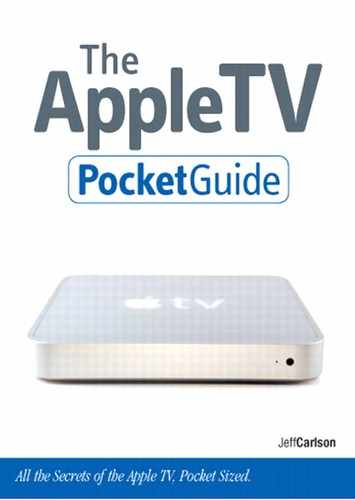Very few people sit down with a bowl of popcorn and expect a pleasant evening in front of the computer. Although you can watch movies and television shows on your Mac or PC, the experience is shackled by tradeoffs: computer monitors are designed for viewing at close range, not across the room; you must navigate the computer’s operating system; the computer is likely not in the living room.
And yet, more entertainment is coming into our homes via computers and the Internet. The Apple TV is the bridge between your computer and television, making it easy for you to watch digital content from the comfort of your couch, not your office chair.
If you’re like many people, you probably have a settop box connected to your television that brings in cable or satellite TV signals. The Apple TV is a similar device, but it delivers video, music, and photos from one or more computers on your home network.
Thanks to the Apple TV’s 40 gigabyte (GB) hard drive, you can copy and store media from one computer, just like connecting an iPod. By synchronizing media in this way, you can play back content even if the computer is powered off or not connected to the network.
If your household includes more than one computer, you can stream content to the Apple TV without copying it to the hard drive first. The benefit here is being able to watch material from any computer without first having to copy the content to the Apple TV. (The exception is photos, which can only be viewed after synchronization; see Chapter 8.)
When the Apple TV was first announced, many people (myself included) were disappointed that it didn’t offer the single greatest television feature in the world: time-shifting. In other words, the Apple TV is not a TiVo, recording broadcast television programs for playback whenever it’s convenient (and skipping past commercials).
When you think about it, however, this isn’t surprising at all: Apple sells TV shows and movies through the iTunes Store, so offering the capability to record broadcast TV would undercut the iTunes business (and lessen the likelihood that entertainment studios would make their shows available on iTunes).
The Apple TV is also not a DVD player, though you can rip DVDs you own for disc-free playback (see Chapter 7 for instructions on how to convert movies to a format that the Apple TV—and iPods—can play).
The good news is, the Apple TV doesn’t need to deal with DVDs or live television programming. It can exist with other components that handle those functions (see Chapter 1).
If you’re skimming this book in an Apple Store or other retail location, waiting for someone to fetch an Apple TV from the stock in the back, make sure you go home with the right gear. If you’re already home, check the following list to see if you need to make a quick run to pick up something. Because once the Apple TV is hooked up and running, believe me, you won’t want to leave the couch for hours.
Apple TV. You won’t get far without one of these.
Widescreen High-Definition or “Enhanced Definition” Television. Sorry, the 10-year-old Panasonic you brought from college just won’t cut it. The TV needs to support widescreen (a 16:9 aspect ratio) resolutions of 1080i, 720p, 576p, or 480p, and include HDMI, DVI, or component ports.
Tip
If you’ve purchased a standard-definition television within the last couple of years, check its connections on the back. It may include component video and audio ports, in which case the Apple TV will work. However, if you’re in the market to buy a new TV, skip these models and get an HDTV; the quality and widescreen aspect ratio going forward will be worth whatever money you would have saved with the standard-definition model.
HDMI or Component Video and Audio Cables. The Apple TV doesn’t include cables, so make sure you buy the type that connect to your TV. Note that component cables are not the same as composite cables. See Chapter 1 for more detail.
Tip
Beware of cable prices! If someone is asking for much more than $20 for an HDMI or component cable, go elsewhere. The Apple Store sells XtremeMac cables for $20, and you can find others online for less.
Computer. The Apple TV gets its content from a Mac or Windows-based PC.
iTunes. If you don’t already have it, download iTunes at www.apple.com/itunes/.
Local Network. Media is transferred over wired Ethernet or wireless network (see Chapter 1).
